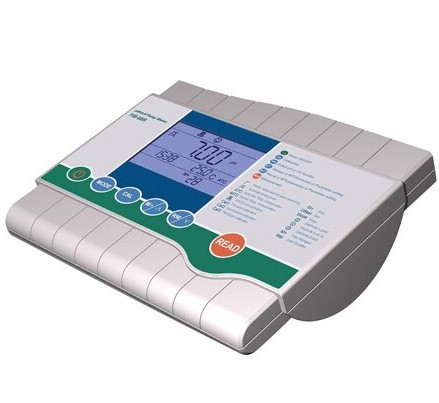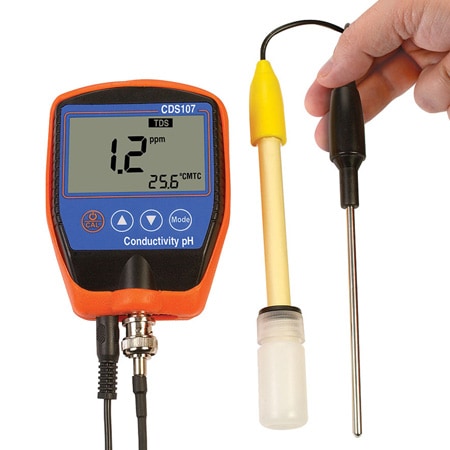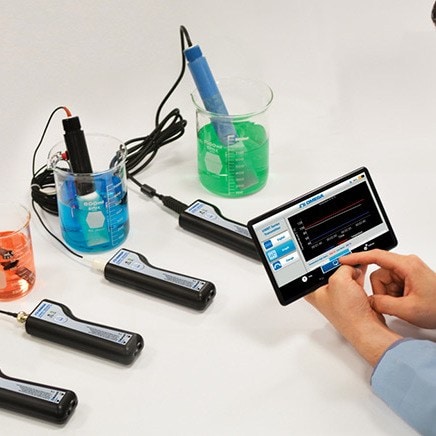Whether you're testing the acidity of a solution in a laboratory, monitoring industrial wastewater, or fine-tuning fermentation in a brewery, accurate pH measurement is essential in so many different applications. pH meters are the precision instruments that convert electrochemical signals into accurate, readable measurements, enabling the monitoring and control of the critical chemical processes needed for these various applications.
What Is pH, and Why Is It Important?
pH is a measure of hydrogen ion concentration, expressed on a scale from 0 to 14. A solution with a pH below 7 is acidic, while a value above 7 is alkaline (basic). A neutral pH is exactly 7.
The pH of a substance influences chemical reactions, biological processes, and equipment performance in any given application. For example:
- In water treatment, pH affects disinfection efficiency and corrosion control
- In pharmaceuticals, pH ensures drug stability and safety
- In agriculture, soil pH impacts nutrient availability and crop yield
Accurate pH monitoring enables consistent quality, regulatory compliance, and optimized process performance.
What Are pH Meters and How Do They Work?
pH meters are electronic instruments that measure the acidity or alkalinity of a solution by detecting the voltage generated by a specialized sensor. More precise than pH paper or visual indicators, a pH meter provides digital or analog readings that reflect the hydrogen ion concentration in a sample.
A complete pH measurement system typically consists of three key components:
- A pH measuring electrode, which is a glass bulb sensitive to hydrogen ions
- A reference electrode, which maintains a stable, known voltage
- A high-impedance meter, which amplifies and interprets the millivolt signal
The pH electrode behaves like a tiny, ion-sensitive battery. It produces a voltage that changes depending on the hydrogen ion activity across the glass membrane. The reference electrode, by contrast, stays constant and serves as a stable comparison point.
Because the signal from the pH electrode is extremely weak (often in the range of millivolts), it’s essential that the meter has very high input impedance. Without it, the tiny voltage could be lost through leakage currents or internal resistance. The pH meter amplifies this signal and converts it into a corresponding pH value, which is displayed in real time.
Types of pH Meters
pH meters come in several configurations to suit specific environments and measurement needs. Common types include:
Benchtop pH Meters
Ideal for laboratory and research applications, benchtop pH meters provide the highest level of precision and stability. These instruments often include features such as automatic temperature compensation (ATC), multi-parameter measurement (e.g., pH, ORP, conductivity, and temperature), advanced calibration modes, and internal data logging for traceability. Their larger display interfaces and stable platforms make them especially suited for rigorous testing environments where reproducibility and accuracy are critical.
Portable pH Meters
Designed for on-site use, portable pH meters are battery-powered, compact, and built to withstand harsh environments. Many models feature waterproof housings, replaceable electrodes, and automatic temperature compensation (ATC) to ensure reliable readings in variable field conditions. Common applications include environmental monitoring, soil and water testing, food safety inspections, and aquaculture. Their convenience and durability make them essential for technicians and researchers conducting pH analysis outside the lab.
Inline or Process pH Sensors
Engineered for continuous, real-time pH monitoring in demanding industrial environments, these sensors are permanently installed in pipelines, tanks, or flow-through systems. They are commonly used in applications like wastewater treatment, chemical processing, food and beverage production, and cooling water systems. Designed to withstand high temperatures, pressures, and aggressive media, these sensors are typically integrated with transmitters or controllers to enable automated dosing, alarms, and process adjustments—ensuring consistent product quality and regulatory compliance.
Why Use a pH Meter?
Historically, chemists have relied on color-changing indicators like litmus paper to estimate the acidity or alkalinity of a solution. These methods are quick and inexpensive, but they’re also inherently limited. Indicator strips provide only rough approximations and cannot deliver the resolution or consistency required for high-stakes applications.
In contrast, digital pH meters are built for precision and repeatability. They’re designed to eliminate guesswork and human variability by directly measuring the electrical potential generated by hydrogen ion activity. This allows them to provide:
- High precision, with resolutions as fine as ±0.01 pH units. This is critical in processes where small pH shifts affect product quality or safety
- Consistent, repeatable, readings, independent of the operator’s skill or visual interpretation
- Digital displays that provide immediate, unambiguous results, improving speed and reducing errors
- Data logging and connectivity, allowing for automated record-keeping, quality control audits, and integration into industrial monitoring systems
Ensuring Measurement Accuracy: How to Calibrate and Care for a pH Meter
Accurate pH readings depend not just on the quality of the meter, but on how well it’s calibrated and maintained. Two critical factors in ensuring reliability are temperature compensation and the use of buffer solutions.
Why Temperature Compensation Matters
Temperature compensation is a critical feature in pH meters because both the pH electrode response and the actual pH of a solution vary with temperature. Modern pH meters include either manual or automatic temperature compensation (ATC) to ensure accurate readings across a range of temperatures.
How to Calibrate a pH Meter
- Ensure the meter's temperature matches the buffer or use ATC.
- Set the meter to “pH” or “ATC” if automatic compensation is used
- Place the clean electrode into a fresh, room temperature pH 7.00 buffer
- Adjust to 7.00 using the ZERO/OFFSET knob
- Rinse the electrode with distilled or deionized water
- Place the electrode into a second buffer (pH 4.00 or pH 10.00)
- Adjust using the SLOPE/CALIBRATE/GAIN controls (coarse)
- Fine-tune with the SLOPE knob to reach exact pH
Calibration with Buffer Solutions
pH meters must be calibrated regularly, which is done using standard buffer solutions with known, stable pH values (typically at pH 4.00, 7.00, and 10.00). These solutions serve as reference points for the meter, allowing it to interpret raw voltage readings accurately.
- For best results, always calibrate at the temperature and pH range closest to your target measurement
- Use fresh buffers and avoid cross-contamination by rinsing the electrode between solutions
- Two-point or three-point calibration is preferred for high-accuracy applications
Regular calibration ensures measurements remain stable, especially when working in variable environments or with aging electrodes.
Connect with a DwyerOmega Expert Today!






